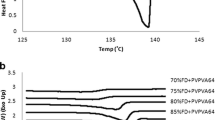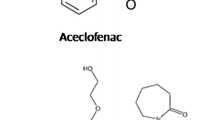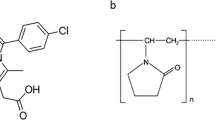Abstract
Purpose
Traditional methods for estimating drug-polymer solubility either require fast dissolution in the polymeric matrix, rapid re-crystallization kinetics from supersaturated states or derive from regular solution theories. In this work, we present a new method for determining drug solubility, purely based on thermodynamic considerations, that uses only experimental data from DSC for calculations.
Methods
The new thermodynamic model presented combines DSC analysis and application of Hess’s law to determine free energies of conversion of binary mixtures to amorphous solid dispersions, free energies of mixing as well as solubility as a function of temperature. The model drug indomethacin and polymers HPMCAS LF, PVP K29/32 and Eudragit EPO were used in these studies.
Results
Free energies were calculated as a function of temperature, for different drug-polymer compositions and the results show that HPMCAS LF solid dispersion with high drug content are less thermodynamically favorable compared to other polymer systems. Solubility of indomethacin in HPMCAS LF, PVP K29/32 and Eudragit EPO was 24, 55 and 56% w/w, respectively, at 25°C.
Conclusions
The thermodynamic model presented has great advantages over traditional methods. It does not require estimation of any interaction parameters, it is almost assumption-free and uses only thermal data for calculations.













Similar content being viewed by others
Abbreviations
- API:
-
Active pharmaceutical ingredient
- ASD:
-
Amorphous solid dispersions
- DSC:
-
Differential scanning calorimetry
- F-H:
-
Flory-Huggins
- G-T:
-
Gordon-Taylor
- HPMCAS:
-
Hypromellose acetate succinate
- IND:
-
Indomethacin
- PM:
-
Physical mixture
- PVP:
-
Polyvinylpyrrolidone
- SDD:
-
Spray dried dispersion
References
Newman A, Knipp G, Zografi G. Assessing the performance of amorphous solid dispersions. J Pharm Sci. 2012;101(4):1355–77.
Serajuddin AT. Solid dispersion of poorly water-soluble drugs: early promises, subsequent problems, and recent breakthroughs. J Pharm Sci. 1999;88(10):1058–66.
Williams HD, Trevaskis NL, Charman SA, Shanker RM, Charman WN, Pouton CW, et al. Strategies to address low drug solubility in discovery and development. Pharmacol Rev. 2013;65(1):315–499.
Zheng W, Jain A, Papoutsakis D, Dannenfelser RM, Panicucci R, Garad S. Selection of oral bioavailability enhancing formulations during drug discovery. Drug Dev Ind Pharm. 2012;38(2):235–47.
Hancock BC, Parks M. What is the true solubility advantage for amorphous pharmaceuticals? Pharm Res. 2000;17(4):397–404.
Murdande SB, Pikal MJ, Shanker RM, Bogner RH. Solubility advantage of amorphous pharmaceuticals: II. Application of quantitative thermodynamic relationships for prediction of solubility enhancement in structurally diverse insoluble pharmaceuticals. Pharm. Res. 2010;27(12):2704–14.
Craig DQM. The mechanisms of drug release from solid dispersions in water-soluble polymers. Int J Pharm. 2002;231(2):131–44.
Simonelli AP, Mehta SC, Higuchi WI. Dissolution rates of high energy sulfathiazole-povidone coprecipitates II: characterization of form of drug controlling its dissolution rate via solubility studies. J Pharm Sci. 1976;65(3):355–61.
Hancock BC, Shamblin SL, Zografi G. Molecular mobility of amorphous pharmaceutical solids below their glass transition temperatures. Pharm Res. 1995;12(6):799–806.
Janssens S, Van den Mooter G. Review: physical chemistry of solid dispersions. J Pharm Pharmacol. 2009;61(12):1571–86.
Flory PJ. Principles of polymer chemistry. Ithaca: Cornell University Press; 1953.
Marsac PJ, Shamblin SL, Taylor LS. Theoretical and practical approaches for prediction of drug-polymer miscibility and solubility. Pharm Res. 2006;23(10):2417–26.
Rubinstein M, Colby RH. Polymer physics. Oxford: Oxford University Press; 2003.
Van Krevelen DW, Te Nijenhuis K. Chapter 7 - cohesive properties and solubility. In: Van Krevelen DW, Te Nijenhuis K, editors. Properties of polymers. Fourth ed. Amsterdam: Elsevier; 2009. p. 189–227.
Hildebrand JH, Scott RL. The solubility of nonelectrolytes. New York: Reinhold Pub. Corp; 1950. x, 488 p. p
Marsac PJ, Li T, Taylor LS. Estimation of drug-polymer miscibility and solubility in amorphous solid dispersions using experimentally determined interaction parameters. Pharm Res. 2009;26(1):139–51.
Zhao Y, Inbar P, Chokshi HP, Malick AW, Choi DS. Prediction of the thermal phase diagram of amorphous solid dispersions by Flory–Huggins theory. J Pharm Sci. 2011;100(8):3196–207.
Sun Y, Tao J, Zhang GG, Yu L. Solubilities of crystalline drugs in polymers: an improved analytical method and comparison of solubilities of indomethacin and nifedipine in PVP, PVP/VA, and PVAc. J Pharm Sci. 2010;99(9):4023–31.
Tao J, Sun Y, Zhang GG, Yu L. Solubility of small-molecule crystals in polymers: D-mannitol in PVP, indomethacin in PVP/VA, and nifedipine in PVP/VA. Pharm Res. 2009;26(4):855–64.
Mahieu A, Willart J-F, Dudognon E, Danède F, Descamps M. A new protocol to determine the solubility of drugs into polymer matrixes. Mol Pharm. 2013;10(2):560–6.
Alin J, Setiawan N, Defrese M, DiNunzio J, Lau H, Lupton L, et al. A novel approach for measuring room temperature enthalpy of mixing and associated solubility estimation of a drug in a polymer matrix. Polymer. 2018;135:50–60.
Bellantone RA, Patel P, Sandhu H, Choi DS, Singhal D, Chokshi H, et al. A method to predict the equilibrium solubility of drugs in solid polymers near room temperature using thermal analysis. J Pharm Sci. 2012;101(12):4549–58.
Almeida e Sousa L, Reutzel-Edens SM, Stephenson GA, Taylor LS. Assessment of the amorphous “solubility” of a Group of Diverse Drugs Using new Experimental and Theoretical Approaches. Mol Pharm. 2015;12(2):484–95.
Rowe RC, Sheskey PJ, Quinn ME. In: Rowe PJS RC, Quinn ME, editors. Handbook of pharmaceutical excipients. 6th ed. London ; Chicago: Pharmaceutical Press; Washington, DC : American Pharmacists Association; 2009.
Tong P, Zografi G. A study of amorphous molecular dispersions of indomethacin and its sodium salt. J Pharm Sci. 2001;90(12):1991–2004.
Laitinen R, Priemel PA, Surwase S, Graeser K, Strachan CJ, Grohganz H, et al. Theoretical considerations in developing amorphous solid dispersions. In: Shah N, Sandhu H, Choi DS, Chokshi H, Malick AW, editors. Amorphous solid dispersions: theory and practice. New York, NY: Springer New York; 2014. p. 35–90.
Gordon M, Taylor JS. Ideal copolymers and the second-order transitions of synthetic rubbers. i. Non-crystalline copolymers. J Appl Chem. 1952;2(9):493–500.
Kalogeras IM. A novel approach for analyzing glass-transition temperature vs. composition patterns: application to pharmaceutical compound+polymer systems. Eur. J Pharm Sci. 2011;42(5):470–83.
Kalogeras IM, Brostow W. Glass transition temperatures in binary polymer blends. J Polym Sci Pol Phys. 2009;47(1):80–95.
Paricaud P, Galindo A, Jackson G. Understanding liquid-liquid immiscibility and LCST behaviour in polymer solutions with a Wertheim TPT1 description. Mol Phys. 2003;101(16):2575–600.
Tian B, Tang X, Taylor LS. Investigating the correlation between miscibility and physical stability of amorphous solid dispersions using fluorescence-based techniques. Mol Pharm. 2016;13(11):3988–4000.
Surana R, Pyne A, Suryanarayanan R. Effect of aging on the physical properties of amorphous Trehalose. Pharm Res. 2004;21:867–74.
Surana R, Pyne A, Suryanarayanan R. Effect of preparation method on physical properties of amorphous Trehalose. Pharm Res. 2004;21:1167–76.
Abiad M, Campanella O, Carvajal MT. Effect of spray drying conditions on the physicochemical properties and enthalpy relaxation of α-lactose. Int J Food Prop. 2014;17(6):1303–16.
Badrinarayanan P, Zheng W, Li Q, Simon SL. The glass transition temperature versus the fictive temperature. J Non-Cryst Solids. 2007;353(26):2603–12.
ACKNOWLEDGEMENTS AND DISCLOSURES
The authors would like to thank Raquel Borda D’Água for the valuable help with some of the DSC work.
Author information
Authors and Affiliations
Corresponding author
Additional information
Publisher’s Note
Springer Nature remains neutral with regard to jurisdictional claims in published maps and institutional affiliations.
Rights and permissions
About this article
Cite this article
Almeida e Sousa, L., Dömötör, K.J., Paiva, M. et al. Drug-Polymer Solubility Determination: A New Thermodynamic Model Free from Lattice Theory Assumptions. Pharm Res 36, 175 (2019). https://doi.org/10.1007/s11095-019-2710-8
Received:
Accepted:
Published:
DOI: https://doi.org/10.1007/s11095-019-2710-8




